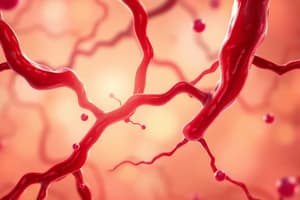Podcast
Questions and Answers
What is the primary difference between primary and secondary hemostasis in terms of the injury size they address?
What is the primary difference between primary and secondary hemostasis in terms of the injury size they address?
- Primary hemostasis addresses injuries to arteries, while secondary hemostasis addresses injuries to veins.
- Primary hemostasis is activated by small injuries, while secondary hemostasis is activated by large injuries. (correct)
- Primary hemostasis involves enzymatic activation, while secondary hemostasis involves only cellular components.
- Primary hemostasis is activated by large injuries, while secondary hemostasis is activated by small injuries.
Which of the following is MOST directly associated with the process of secondary hemostasis?
Which of the following is MOST directly associated with the process of secondary hemostasis?
- Formation of a platelet plug.
- Enzymatic activation of coagulation proteins. (correct)
- Vasoconstriction at the injury site.
- The immediate, short-lived response to vascular damage.
What is the role of the vascular system in hemostasis?
What is the role of the vascular system in hemostasis?
- To provide the initial response to vascular injury by producing a platelet plug. (correct)
- To initiate the enzymatic activation of coagulation proteins.
- To facilitate the long-term response to blood vessel injuries.
- To contribute cellular components that aid in rapid, short-lived responses.
What is the ultimate goal of hemostasis?
What is the ultimate goal of hemostasis?
Which component is MOST associated with primary hemostasis?
Which component is MOST associated with primary hemostasis?
How does the duration of response differ between primary and secondary hemostasis?
How does the duration of response differ between primary and secondary hemostasis?
Which of the following is an example of a cellular component that plays a key role in hemostasis?
Which of the following is an example of a cellular component that plays a key role in hemostasis?
Following a deep cut, secondary hemostasis is initiated. What would be the expected outcome of this process?
Following a deep cut, secondary hemostasis is initiated. What would be the expected outcome of this process?
Flashcards
Primary Hemostasis
Primary Hemostasis
The body's rapid response to vascular injury, forming a platelet plug at the damage site. It is activated by minor injuries to blood vessels.
Secondary Hemostasis
Secondary Hemostasis
A slower, longer-term bodily response to significant blood vessel injuries. Involves activating coagulation proteins to convert fibrinogen into fibrin.
Hemostasis
Hemostasis
The overall process that maintains blood fluidity, forms clots at injury sites, confines clots, and dissolves them as wounds heal.
Vascular System
Vascular System
Signup and view all the flashcards
Cells of vascular intima
Cells of vascular intima
Signup and view all the flashcards
Platelets
Platelets
Signup and view all the flashcards
Small Injury
Small Injury
Signup and view all the flashcards
Large Injury
Large Injury
Signup and view all the flashcards
Study Notes
- Hemostasis, coagulation and fibrinolysis are all related medical concepts
Overview of Hemostasis
- Blood inside the blood vessel should have no coagulation and remain fluid
- Blood outside the blood vessel undergoes coagulation, also known as hemostasis
- Hemorrhagic disease is an abnormal mechanism of no coagulation
- Thrombosis disease is an abnormal mechanism of coagulation
- Hemostasis is the process that keeps blood fluid in the circulation
- When an injury occurs, hemostasis produces a clot to stop the bleeding
- Hemostasis keeps the clot confined to the site of injury
- Hemostasis finally dissolves the clot as the wound heals
Key components of Hemostasis
- Cellular components
- Cells of vascular intima
- Extravascular tissue factor bearing cells
- Platelets
- Plasma components
- Coagulation proteins
- Fibrinolytic proteins
- Inhibitors
Primary Hemostasis
- Response to vascular injury creates a platelet plug at the site of damage
- Activated by small injuries to blood vessels
- It's a rapid, short-lived response
- The result: platelet plug
- Components:
- Vascular system, including arteries, veins and capillaries
- Platelets from endothelial cells
Secondary Hemostasis
- Activated by large injury to the blood vessels
- Delayed, long-term response
- The enzymatic activation of coagulation proteins produce fibrin from fibrinogen
- Fibrin forms like a mesh
- This stabilizes the platelet plug that forms in primary hemostasis
- Components:
- Coagulation factors, including factor B
- Inhibitors
Fibrinolysis
- The stable clot is dissolved via proteolytic digestion of fibrinogen and fibrin by the enzyme plasmin
- Fibrinolysis is the final event of hemostasis
- Fibrinolyic proteins are involved
Studying That Suits You
Use AI to generate personalized quizzes and flashcards to suit your learning preferences.




